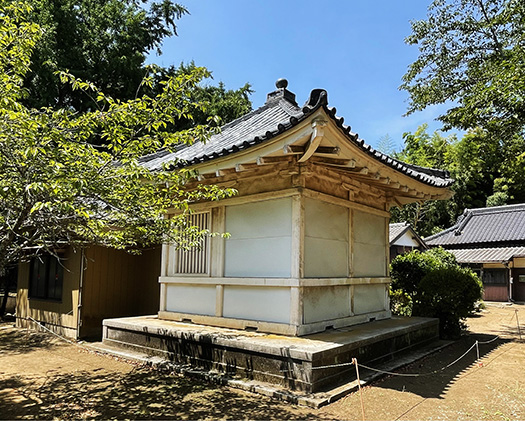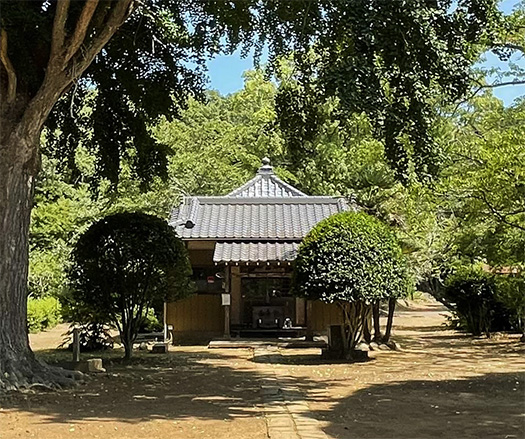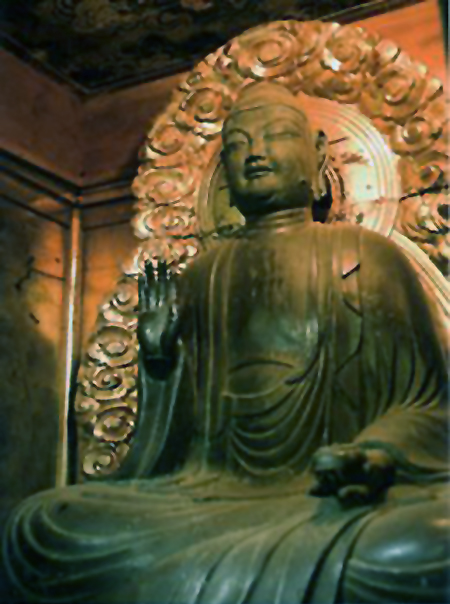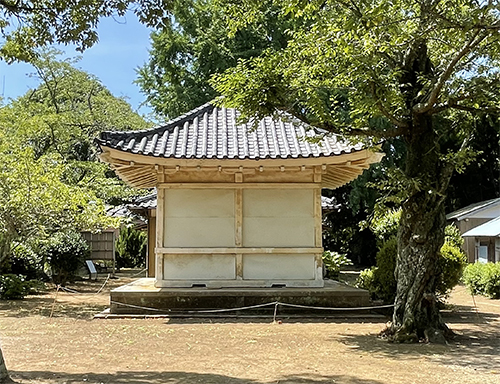


さて龍角寺についての探索、いろいろな資料を参照しながら進めてみて、やはり気になるのはほかの関東地域の豪族の遺跡と比較して中央王権としても仏教導入始原期にもかかわらず、なぜこの地に本格的仏教寺院が開設されたのか、ということ。
また、この印波国造の支配地域のなかでも龍角寺周辺の古墳群と、それに先行する古墳群とは明確にその主体者の性格に差異が見られるという専門的所見があること。
こうした疑問は大きなナゾとして、ドンドン深まってきていた。
そういうなかでこの龍角寺のすぐ近くの「房総のむら」の「主任上席研究員」の白井久美子先生の発表文の一節に強く惹かれています。氏はとくに軍事機能を表徴する「毛彫り馬具」に注目されている。
〜6世紀以降の馬具製作には、鞍作りと仏師がともに関わったと考えられている。鞍作止利に代表される「止利派」は、推古朝における中心的な仏像製作者集団として飛鳥寺・法隆寺本尊を造像した点が知られているが、金銅薄板造りの馬装には彼らの関与が推定されている。特に、仏教色が強まった7世紀の金銅製毛彫馬具は、仏教美術の担い手によって製作された可能性の高い製品であり、新たな時代の息吹を映した馬具といえる。(中略)毛彫馬具の分布は、東日本に偏っているのが特徴(図1)で、特に、古代の東山道と東海道に集中し、群馬県(上毛野)と、静岡県(駿河)から茨城県(常陸)の分布が他を圧倒している。これらは、東北へ向かう内陸道、海道の要衝で、新式の道上型毛彫馬具は、東北
進出を図る王権の政策に応じて、活躍した東国軍団への勲章だったのかも知れない。〜
房総のむらは関東でも屈指の「民俗村」としてすばらしく、わたしも探索させていただき、ことし1月には全13回のブログシリーズでも紹介させていただいた。(連載1回目にリンクしたので辿ってみてください)

そういうことなので個人的体験としても親近感があり、そちらの主任上席研究員としての探究結果には強く刮目させられる。こうした物証に踏まえての論説には非常に説得力があります。王権は京都に遷都した桓武帝以降、東北地域への進出、征夷を活発化させるけれど、関東はその武力涵養地域として意図的に勢力を育成していったという説。それも600年代中期ころから意図していたということ。そういった意図からこの地域の勢力を武力の涵養地域権力として育てていった。
後の時代の武家の棟梁・源義家は、勿来の関という福島県太平洋側から東北に進出していくのだけれど、その根拠地・出撃準備地域として下総・印波の地域で、この龍角寺を営んだ勢力が役割を果たしたというのは非常に蓋然性が高いと思います。
日本史と建築の探究、点と線が繋がってくるような楽しさであります。
English version⬇
Ryukaku-ji Temple, a strategy for fostering powerful warriors as a base for the “conquest of the barbarians” in the Tohoku region (6): Exploration of Three Shrines in the East – 13
The royal power eventually began full-fledged conquest of the northeastern part of Japan, but it also fostered the power of Inba and other areas as a base for training military forces and nurturing Kanto samurai. The Inba forces and other organizations were fostered as a base for training the warriors of the Kanto region.
In my search for Ryuzaku-ji Temple, I consulted a variety of sources and found that, in comparison with the remains of other great families in other areas, the central royal authority was in the early stages of introducing Buddhism, so why was a full-scale Buddhist temple established in this area?
In addition, there is a specialized finding that there is a clear difference between the tombs around Ryukakuji Temple and those that preceded it in the area ruled by the Inba-no-Kokuzo, in terms of the character of the subjects of the tombs.
These questions were becoming more and more puzzling.
In this context, I was strongly attracted by a passage in the presentation by Ms. Kumiko Shirai, the “chief senior researcher” of “Boso no Mura” near Ryukakuji Temple. She is particularly interested in “hair-carved harnesses” that represent military functions.
〜It is thought that saddle makers and Buddhist priests were both involved in the production of harnesses from the 6th century onward. The “Toryi School,” represented by Kurazaki-Toryi, is known as the main group of Buddhist statue makers in the Suiko period who created the main statues of Asukadera and Horyuji temples, and their involvement in the production of gilt bronze thin plate horse mounts is also presumed. In particular, the gilt-bronze horse tack of the 7th century, when Buddhist colors became stronger, is highly likely to have been produced by the leaders of Buddhist art, and it can be said that it reflects the breath of a new age. (The distribution of carved bridles is characterized by a bias toward eastern Japan (Fig. 1), particularly concentrated along the ancient Higashiyama and Tokaido highways, with Gunma (Kamimono) and Shizuoka (Suruga) to Ibaraki (Hitachiniku) prefectures dominating the rest of the country. These were the key points on the inland and maritime highways leading to the Tohoku region, and the new style of roadside carved horse tack was used in the Tohoku region.
The new style of Doujo-style carved horse mounts may have been a medal of honor for the Eastern army corps that responded to the policy of the royal government to advance into the Tohoku region. ~.
The villages of Boso are some of the finest “folk villages” in the Kanto region, and I have explored them myself, introducing them in a 13-part blog series in January of this year. (Please follow the link in the first article of the series.)
As such, I feel a sense of familiarity with his personal experience, and I am strongly impressed by the results of his research as the chief senior researcher of the project. Your editorial based on such physical evidence is very persuasive. The theory is that the royal power intentionally fostered its power in the Kanto region as a place to cultivate its military strength, although it became more active in advancing into the Tohoku region and conquering the barbarians after the Emperor Kanmu moved the capital to Kyoto. This was the intention from the mid-600s. With this intention, the power in this region was nurtured as a regional power to cultivate military strength.
Minamoto no Yoshiie, the leader of the warrior class in the later period, advanced into the Tohoku region from the Pacific Ocean side of Fukushima Prefecture called Nakosunoseki, and it is highly probable that the forces that operated the Ryukakuji Temple in the Shimousa/Inba area played a role as a base and preparation area for his advance.
It is a pleasure to connect the dots and lines between Japanese history and architectural exploration.
Posted on 8月 17th, 2023 by 三木 奎吾
Filed under: 日本社会・文化研究, 歴史探訪







コメントを投稿
「※誹謗中傷や、悪意のある書き込み、営利目的などのコメントを防ぐために、投稿された全てのコメントは一時的に保留されますのでご了承ください。」
You must be logged in to post a comment.